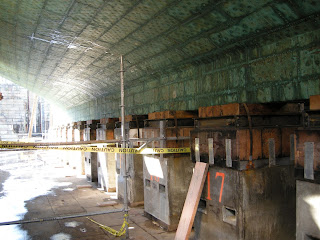Since we are soon in British waters, I thought the following story regarding the wreck of a Dutch ship might be appropriate. Enjoy!
In 1740, a Dutch merchant ship
called 'De Rooswijk' sank on the notorious Goodwin Sands in Kent, killing all
350 people on board.
Now, almost 280 years later, a huge
research mission is being launched to salvage the enormous merchant ship.
Researchers hope that recovering the
wreck will provide valuable insights into life during the Dutch Golden Age.
De Rooswijk belonged to the Dutch
East India Company (VOC) and was built in 1737.
In 1740 it set sail from the
Netherlands on its second voyage to the East, laden with silver ingots and
coins to buy up hugely profitable spices in what is now known as Indonesia.
Yet the ship never made it to Asia
as it went down just off the British coast in January 1740, with all 350 people
on board drowning.
Divers have already been exploring
the wreckage site near the town of Deal in Kent to unlock some of its secrets
since it was discovered in 1996.
 |
| underwater view of the remains |
In 2004, diver Ken Welling visited the wreck, and
retrieved two complete chests and hundreds of silver bars. Several dives since
have recovered hundreds of Mexican silver cobs of the 1720s and early 1730s,
and transitional 'klippes' coins that date to around 1733.
Hundreds more 'pillar dollars' have
also been discovered and sold at auction.
 |
| wood and silver recovered from the wreck |
Today, the Dutch government
announced plans to salvage the wreck so it can be fully investigated.
Maritime archaeologist Mr Martijn
Manders, who will lead the research, said: 'A big part of our history lies on
the bottom of the sea.'
As the wreck is being threatened by
currents and a future sand extraction project there is some urgency involved.
Ms Jet Bussemaker, Dutch Minister for Education,
Culture and Science said: 'The ship offers a unique look to the past. The
archaeological information which we can get out of the wreck is of utmost value
to interpret this period in our history.'
Mr Manders hopes that by retrieving
the full inventory of the ship, a lot more secrets will be uncovered about
maritime trade during the Dutch Golden Age.
He said: 'A part lies underneath the
sand, where the conditions are very good.
Maritime archaeologists and students
from both the UK and the Netherlands will work on the project from July to
October, 24 hours a day, in shifts lasting twelve hours.
Those shifts will be arduous to say the least!
Should more appear on this story we will endeavor to bring it to you.... should be interesting.
Until next time (and likely from the comfort of dry land and a fast(er) wifi signal!)
Fair Winds,
Old Salt












